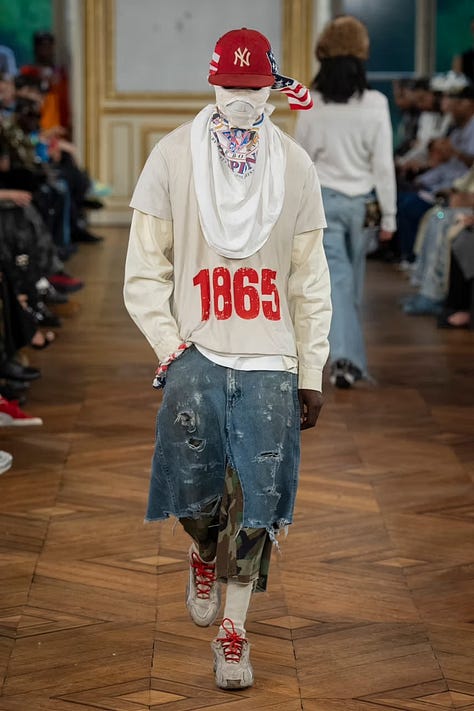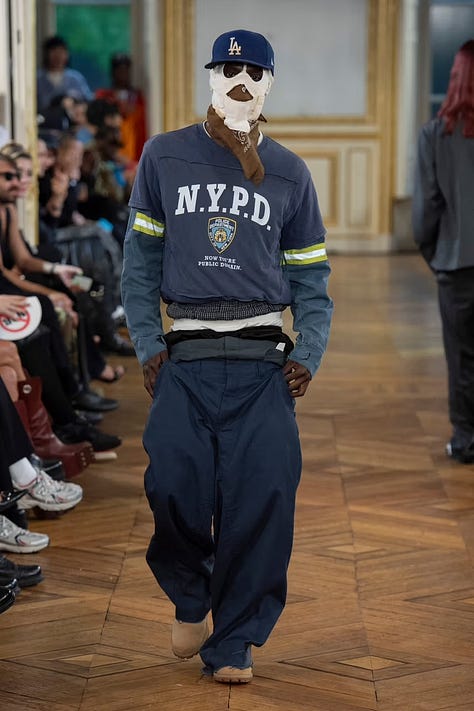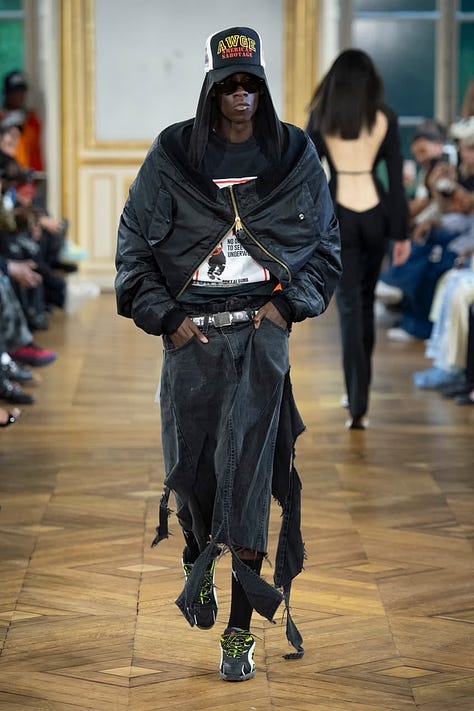Runway Reflects Reality #1: A$AP Rocky, Sagging Bans, and Protest
The beginning of a series discussing how fashion connects to our everyday lives.
A$AP Rocky debuted his first runway collection “American Sabotage” at Paris Fashion Week on June 21, 2024. Drawing on his own experience with the carceral system, the collection critiques who is seen as dangerous and safe. It features pants with stacked waistlines akin to sagging, inverted bomber jackets, anti-surveillance wear, and clothing with phrases like “American Sabotage”, “Political Satire”, and “Don’t Be Dumb.”
These looks explore the American dream, initially through a relaxed suit, but as the collection progresses, stacked suit pants that replicate the same sagging effect conveyed by the stacked denim later in the collection. Almost immediately, the viewer is taken from the American dream to what is presumably the American nightmare or the American sabotage. Tattered jeans and inverted bomber jackets work to comment on how clothing use varies according to one’s societal positioning. One of the main functions clothing serves in this collection is protecting or hiding the models identity. This collection notably features screen-printed tops with bulletproof vests that say “American Sabotage.”



Different aspects of the collection come to a head mid-way through the show. Look 14 features a model with their face covered by a white mask, a brown bandana, and an LA dodgers hat; a t-shirt with the New York Police Department logo with the phrase “Now You’re Public Domain” over a blue work shirt with reflective sleeves; stacked boxers and stacked suit pants; and work boots. By combining police and policed aesthetics, Rocky is able to outline the inconsistencies with how politics of dress are approached.
“Do you trust me?” is the question screaming out behind the look. The model’s face is obscured, but the phrase “Now You’re Public Domain” is an anagram for NYPD that warns viewers about surveillance and celebrity life. Rocky’s life is already open to discussion by virtue of him being a Black man, but his status as a public figure exposes him to more critique and surveillance.
Although the model wears the NYPD logo, he also has “sagging” pants which have been historically associated with criminality, poverty, Blackness, and hip-hop. During the 2000s, states across the country implemented sagging bans. Looks earlier in the collection featured a shirt boasting “No one wants to see your underwear” and “Don’t be dumb” call to these bans. By incorporating perceived criminality into the look of people who are the presumed opposite of criminal, he’s able to disrupt notions of who should and shouldn’t be trusted.
Anti surveillance wear has been present on the runway in the last few seasons, but “American Sabotage” debuts during a time where right-wing politicians are linking covering one’s identity to inherent criminality. North Carolina recently reinstated a bill that prohibits wearing any mask in public with the exceptions of Halloween costumes, secret societies, and surgical and medical grade masks to prevent the spread of illness. This bill was originally called “Unmasking Mobs and Criminals”.
People have been incorporating anti surveillance wear into their daily lives in an effort to protect themselves from facial recognition technology that creates concerns about privacy and racial discrimination. In recent months anti surveillance clothing has been used to protect the identity of protestors as they protest Israel’s genocide of Palestinians. American politicians have been quick to call these students criminals based on this version of masking. The “American Sabotage” collections comments on anti surveillance wear by linking it material success questioning what and who is “criminal”.
The story of this collection can be read as obvious since it is Rocky’s first collection. However, by departing from traditional, subtitle commentary provided by some designers, he is able to prevent ideas of Blackness, criminality, history, and surveillance from falling out of the conversation surrounding fashion.
XXXXXXXXXXXXXXXXXXXXXX


